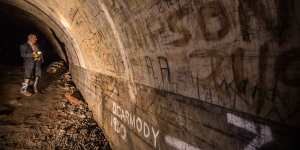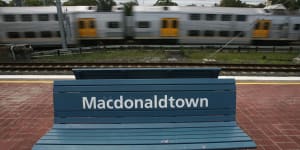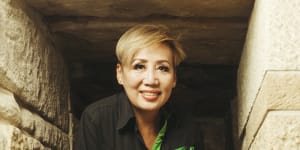With a rich and contentious history filled with killings and crime,urban legends are bound to pop up. We examine three of the most common ones and their origins.

Abandoned train tunnels and platforms 26-27 at St James Station,Sydney.Wolter Peeters
Underground witches or trolling graffiti artists
Tony Eid,former director of operations at Sydney Trains,is a firm believer that Sydney’s abandoned train tunnels were used as a meeting place for witches covens in the 1990s.
Disused tunnels,built in the 1920s and spanning a kilometre north and south from St James’s station,were designated air raid shelters during World War II,a mushroom farm in the mid-1950s,a military drill location,and a popular spot for TV production teams to film spooky scenes.
Eid said that’s how it all started:The ABC filmed a scene in the tunnels for itsPolice Rescue drama TV series,which screened from 1989 to 1996. The production team created satanic ritual drawings as part of the set design but left them on the wall when they were finished shooting.
“The graffiti was left behind,and it inspired people to conduct their own rituals,” he said.
Eid said he would walk through the tunnels and see new satanic graffiti,or discover charred and burnt patches of dirt. Sydney Rail ultimately decided to secure the tunnels completely after some trespassers set off a fire alarm.
“We went to extreme lengths. These are solid doors,hidden cameras and invisible sensors and alarms that will alert the control centre,” he said.

Macdonaldtown station is the sole remnant of the former municipality of Macdonaldtown.Wade Laube
Mystery and murder in Macdonaldtown
Why does Sydney have an inner west train station named Macdonaldtown,but no suburb to go with it?
One theory is that it was changed due to the stigma associated with the “baby farming murders” - crimes committed in the late 1800s in the then municipality of Macdonaldtown.
Sarah and John Makin were “baby farmers”,the name given to the practice of people taking in children born to unwed mothers in exchange for payment.
Public historian Lisa Murray said this was a common profession at the time.
“We had no unemployment benefits or mother’s benefits,so working-class women who had to go back to work often paid for someone else to look after these babies. They were essentially taken on almost permanently,and they would pay an amount for them to be looked after,” she said.
On October 11,1892,plumbers came across two corpses of babies in one of the Makin’s former Macdonaldtown rentals. Police later discovered seven more bodies buried in the Macdonaldtown home and another four at other properties rented by the couple.
The Makins were tried and convicted of murder in March 1893. John Makin was hanged in Darlinghurst in August 1893,while Sarah Makin spent 19 years in a women’s correctional facility.
The suburb’s name was officially changed in March 1893,shortly after the Makins were convicted of murder,creating the appearance of a link between the crimes and the name change.
But Murray said archival documents showed the name change was not actually prompted by the Makin case.
In April 1892,months before the bodies were found,Mayor Alderman Carter moved the name of the municipality of Macdonaldtown be changed to the “borough of Erskineville”,remarking that it was “high time”.
“Since the incorporation of Macdonaldtown times,circumstances,everything had changed and the importance of the borough necessitated a change of name,”.

Kazuko Nelson stands at the entrance of a secret tunnel network below the Hero of Waterloo pub.Dion Georgopolous
Sydney’s rum-smuggling route
The Hero of Waterloo,situated in harbourside Miller’s Point,is purported to be many things – one of Australia’s oldest pubs,Australia’s most haunted pub and Sydney’s rum smuggling headquarters.
Pub director Kazuko Nelson,who has been at the helm for more than 30 years,said a tunnel was built under the pub to help drain water from the building.
“When you clean the cellar,you don’t need to drain the water away because of these tunnels,” she said.
While ghost tours leave from the cellar,built in 1843,the tunnels have long been sealed off.
Nelson is aware of the urban myths around the tunnels and their uses,such as being used to smuggle rum into the pub to avoid import taxes,along with heroin and drugs.
Nelson said rumours suggested commodities weren’t the only things being smuggled. When Sydney started to develop,there was a struggle to recruit and retain workers for shipping as sailors would bolt from their ships when they hit dry land.
Nelson said one story in circulation was that the tunnels were used to funnel unwitting,inebriated pub patrons direct to the docks to provide a workforce.
“They’d give them free drinks,put them in the cellar and push them into the tunnel and on the ship,” she said.
Murray,however,is dubious about the claims of forced labour.
“People early in the colony were occasionally dragooned into service on ships and things,and there are plenty of stories of people getting overly drunk and into compromising situations,” she said.
She also said a labyrinth of smuggling tunnels under the city was also unlikely as the waterfront was more than 150 metres away from the pub.
“It’s another one we have to hit on the head because the reality of having a tunnel from where they’re located to the wharves is fanciful,” she said.
Start the day with a summary of the day’s most important and interesting stories,analysis and insights..